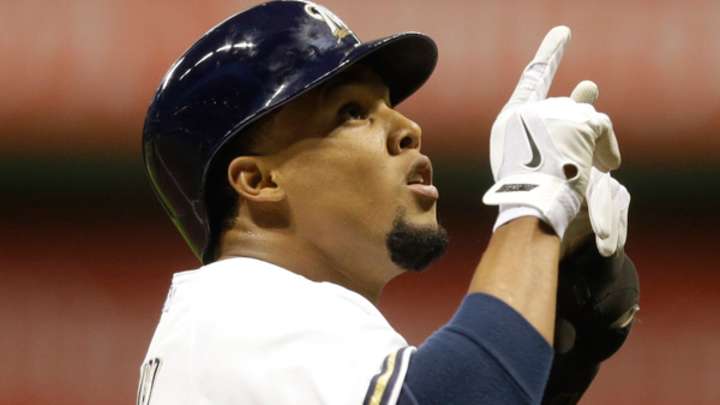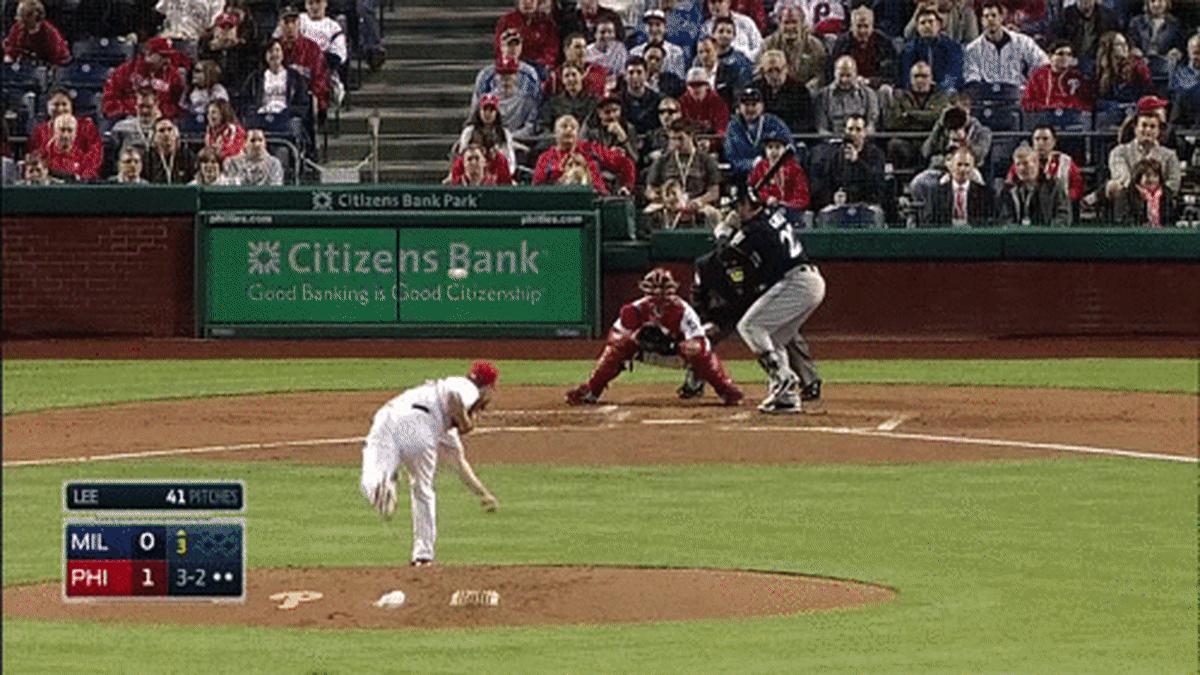Hot start for Brewers' Carlos Gomez highlights magnitude of his breakout

Carlos Gomez has evolved into one of baseball's best players. (Jeffrey Phelps/Getty Images)

This early in the season, several hitters are lighting up the box scores with impossible-to-sustain performances, but at the moment, the claim for hottest hitter on the game's hottest team belongs to Carlos Gomez. On Thursday night, the Brewers' centerfielder went 3-for-5 with a triple, his fifth multi-hit game during a 6-0 road trip in which the team swept both the Red Sox and Phillies. Milwaukee is off to a 7-2 start, tied with Washington for the game's best record, and Gomez is a big reason why.
Gomez's triple on Wednesday actually didn't figure in the scoring in the Brewers' 6-2 win, but it was entertaining given his burst of speed and Phillies rightfielder Marlon Byrd's futile defensive effort, so let's go ahead and roll that GIF:

Since going 2-for-10 in the Brewers' opening series against the Braves, Gomez is 14-for-31 with six extra base hits and 25 total bases. In that span, he has a four-hit game, two three-hit games and two two-hit games to his credit en route to a batting line — .390/.432/.732 — that could come straight from a video game. He won't sustain those numbers, but on the heels of a season in which he led the National League in Baseball-Reference.com's version of Wins Above Replacement (8.9) by hitting .284/.338/.506 with 24 homers, 40 steals and a whopping 38 Defensive Runs Saved, it's a reminder of just how dramatically he has turned his career around.
Gomez broke into the majors with the Mets in 2007, when he was 21. He hit just .232/.288/.304 in 139 plate appearances before the Mets included him as a key piece in their trade for Johan Santana the following winter. He didn't improve upon that line much in his two years with the Twins or his first two years with the Brewers, who traded J.J. Hardy to acquire him in November 2009. Through his age-25 season, his major league line stood at a grim .243/.291/.357 (73 OPS+) through 1,678 plate appearances. He began showing power in mid-2012, homering 15 times from July onward and finishing the year at .260/.305/.463 with 19 dingers and 37 steals, upon which the Brewers rewarded him with a three-year, $24 million extension. Dating back to the start of 2012 (his age 26 season), he has hit a combined .278/.328/.497 (119 OPS+) in 1,086 plate appearances.
How rare is it for a player to turn his career around like that? Using the B-Ref Play Index and a player pool dating back to 1947 (the "Integration Era") to keep the size of my search manageable, I found 132 players who had at least 1,000 plate appearances through their age-25 seasons and then 1,000 from age 26 onward. Among that group, Gomez is in a virtual tie for the largest gain in terms of OPS+ from the first segment of his career to the second, and he's among some familiar names, including a Hall of Famer:
Rk | Player | PA | AVG/OBP/SLG | OPS+ | PA | AVG/OBP/SLG | OPS+ | Gain |
|---|---|---|---|---|---|---|---|---|
1T | Carlos Gomez | 1678 | .243/.291/.357 | 73 | 1086 | .278/.328/.497 | 119 | 46 |
Todd Hundley | 1304 | .219/.271/.355 | 70 | 3001 | .241/.340/.484 | 116 | 46 | |
3T | 2657 | .267/.328/.379 | 85 | 1624 | .313/.351/.464 | 125 | 40 | |
1914 | .262/.316/.360 | 76 | 2723 | .299/.355/.438 | 116 | 40 | ||
5 | 1049 | .245/.290/.375 | 71 | 4645 | .278/.327/.441 | 102 | 31 | |
6 | 1064 | .256/.303/.389 | 79 | 7548 | .306/.352/.448 | 108 | 29 | |
7 | Alan Ashby | 1083 | .220/.303/.303 | 72 | 3616 | .252/.325/.378 | 99 | 27 |
8T | Damion Easley | 1189 | .243/.314/.335 | 72 | 5022 | .255/.332/.421 | 97 | 25 |
Jose Guillen | 1943 | .263/.307/.402 | 82 | 4475 | .273/.328/.456 | 107 | 25 | |
Ozzie Smith | 2029 | .233/.296/.283 | 67 | 8749 | .269/.347/.339 | 92 | 25 | |
Stan Javier | 1102 | .236/.307/.302 | 73 | 4653 | .277/.354/.378 | 98 | 25 |
Gomez is tied atop the list with Hundley, who didn't show much offense in three seasons and change (1992-94, plus slivers of 1990 and 1991) as the Mets' catcher before breaking out; he hit 71 homers and earned All-Star honors twice in 1996-97, but he needed Tommy John surgery on his right elbow late in that latter season, and during his absence, the Mets traded for Mike Piazza. After a disastrous attempt to turn him into a leftfielder, he was traded to the Dodgers, but due to recurring lower back woes had just one good season out of the next five before disappearing from the major league scene.
The next four names on the list are familiar ones:
• Cabrera debuted with the Yankees as a 20-year-old in 2005 but didn't post an OPS+ above 100 until his age-26 season, 2011 with Kansas City. His work in the second segment of his career has been tarnished by his 50-game PED suspension in late 2012, which cost him a batting title. After a miserable 2013 with the Blue Jays, he's off to a hot start this year, with an AL-best four homers and a .333/.333/.644 line in 45 PA. In fact, he leads the AL in total bases with 29, while Gomez leads the NL with 30.
• Molina built a reputation as a great defensive catcher from 2004-10, and developed some on-base skill during the latter half of that run. Even so, he had just one season with a 100 OPS+ through age 27, and had never hit more than eight homers in a year. His offense has grown by leaps and bounds since, as he's hit a combined .313/.359/.484 for a 131 OPS+, and he's finished in the top five in the NL in both WAR and the MVP voting in the last two years.
• After debuting as a 21-year-old in September 2002, Phillips hit .208/.242/.311 in 112 games for the Indians in 2003. Exiled to the minors for further seasoning, he played just 12 major league games over the next two years before being traded to Cincinnati in April 2006, at the start of his age-25 season. He's won four Gold Gloves and made three All-Star teams since, though the last time he posted an OPS+ above 100 was in 2011; his 118 that year (on .300/.353/.457 hitting) is his only time above 103.
• Young played in just two games before his age-24 season (2001), but after two mediocre years with the Rangers, he reeled off a streak of five straight 200-hit seasons, part of a nine-year run in which he averaged 202 hits and earned All-Star honors seven times. His defense was generally subpar, and his -2.9 WAR over his final two seasons (2012-13) before retiring this spring was downright brutal, but that doesn't lessen his development into an effective hitter for that run.
As for Smith, the Wizard of Oz had already won a pair of Gold Gloves during his first four years with the Padres (1978-81), his age 23-26 seasons, but he hit an execrable .231/.295/.278 (66 OPS+) in that span before being traded to St. Louis in a December 1981 blockbuster. He proceeded to help the Cardinals to three pennants over the next six seasons, posting OBPs as high as .392, stealing as many as 57 bases and establishing himself as one of the greatest defenders of all time; he won Gold Gloves in each of his first 11 seasons as a Cardinal. He received 91.7 percent of the vote when he came up for election to the Hall of Fame in 2002, and today he ranks eighth all time in JAWS among shortstops.
Because of the chronological cutoff I chose, one Hall of Famer just missed making the list, and another Cardinal at that: Red Schoendienst. Joining St. Louis as a 22-year-old in 1945, he hit just .270/.312/.345 for a 77 OPS+ during his first four years but earned All-Star honors twice thanks to superficially respectable batting averages, a smattering of gap power, and solid defense. Highlighted by a .307/.359/.427 (110 OPS+) run from 1952-57, his 100 OPS+ over the final 15 years of his career (1949-63) made for a 23 percent gain relative to the league, which would have put him in a tie for 12th. He was elected to the Hall of Fame by the Veterans Committee in 1989.
